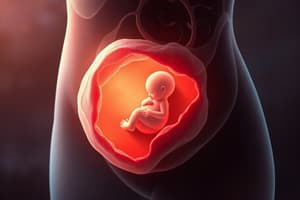Podcast
Questions and Answers
Which substances are transferred from maternal blood to fetal blood for nutrition?
Which substances are transferred from maternal blood to fetal blood for nutrition?
- Gases and antibodies
- Carbon dioxide and waste products
- Nutrients and electrolytes (correct)
- Microorganisms and urea
How does the fetus receive oxygen?
How does the fetus receive oxygen?
- By diffusion within its own body
- Through the maternal lungs
- From the maternal blood across the placental barrier (correct)
- Through amniotic fluid exchange
Which of the following is NOT a function of the placenta?
Which of the following is NOT a function of the placenta?
- Gases exchange
- Nutrient transfer
- Protection against all microorganisms (correct)
- Excretion of metabolic wastes
What kind of immunity is provided by the placenta to the fetus?
What kind of immunity is provided by the placenta to the fetus?
Which waste products are excreted from the fetal blood to the maternal blood via the placenta?
Which waste products are excreted from the fetal blood to the maternal blood via the placenta?
Which function of the placenta is involved in preventing congenital anomalies of the fetus?
Which function of the placenta is involved in preventing congenital anomalies of the fetus?
Which substance does NOT commonly pass through the placental barrier as part of the nutrition function?
Which substance does NOT commonly pass through the placental barrier as part of the nutrition function?
Which condition is NOT typically transmitted across the placenta?
Which condition is NOT typically transmitted across the placenta?
Which role involves the transfer of carbon dioxide from the fetal blood to the maternal blood?
Which role involves the transfer of carbon dioxide from the fetal blood to the maternal blood?
What is a primary outcome of the excretion function of the placenta?
What is a primary outcome of the excretion function of the placenta?
Flashcards are hidden until you start studying
Study Notes
Placental Functions
- Oxygen from maternal blood crosses the placental barrier to the fetus, while carbon dioxide from the fetus crosses back to maternal blood
- The placenta facilitates nutrient exchange:
- Carbohydrates, fats, proteins, amino acids, vitamins, and minerals from maternal blood are transferred to the fetus
- Waste products, such as urea and uric acid, are removed from the fetus through the placenta to maternal blood
Immunological Protection
- The placenta permits the passage of IgG antibodies from maternal blood to fetal blood, providing passive immunity
- It prevents most microorganisms and drugs from passing from maternal blood to fetal blood
Important Exceptions
- Certain pathogens, such as poliomyelitis, AIDS, syphilis, and measles, can cross the placental barrier and cause congenital anomalies
- A few drugs can also cross the barrier, resulting in fetal harm
Placental Functions
- Oxygen from maternal blood crosses the placental barrier to the fetus, while carbon dioxide from the fetus crosses back to maternal blood
- The placenta facilitates nutrient exchange:
- Carbohydrates, fats, proteins, amino acids, vitamins, and minerals from maternal blood are transferred to the fetus
- Waste products, such as urea and uric acid, are removed from the fetus through the placenta to maternal blood
Immunological Protection
- The placenta permits the passage of IgG antibodies from maternal blood to fetal blood, providing passive immunity
- It prevents most microorganisms and drugs from passing from maternal blood to fetal blood
Important Exceptions
- Certain pathogens, such as poliomyelitis, AIDS, syphilis, and measles, can cross the placental barrier and cause congenital anomalies
- A few drugs can also cross the barrier, resulting in fetal harm
Studying That Suits You
Use AI to generate personalized quizzes and flashcards to suit your learning preferences.




